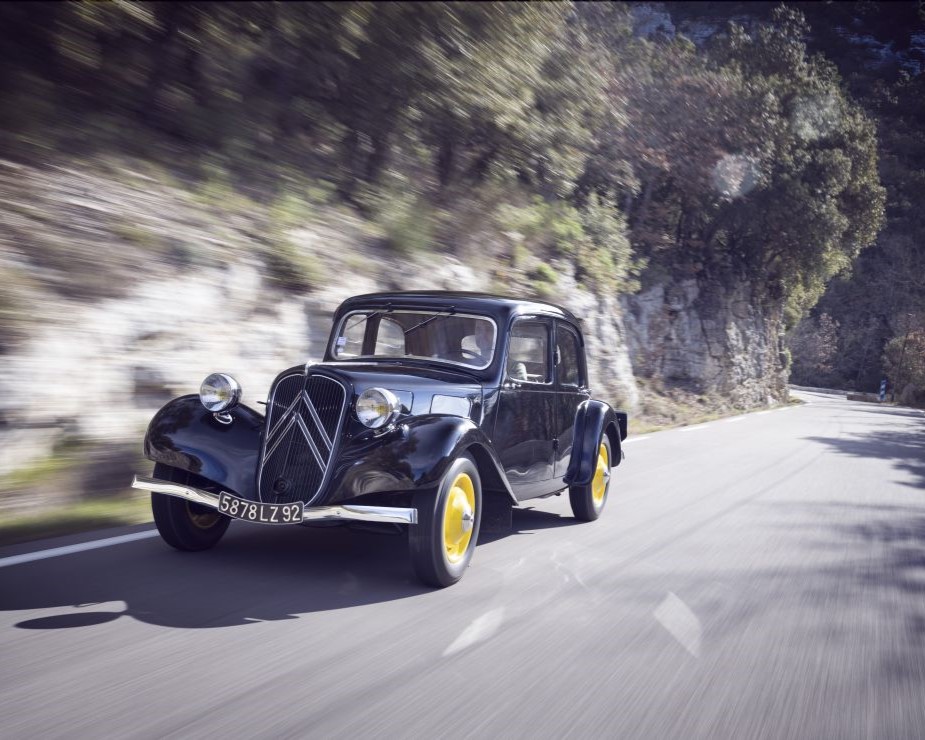In the journey of automotive design, few models have left as indelible a mark as the Citroën Traction Avant. Unveiled in Paris on 18 April 1934, this model was a beacon of innovation, combining advanced technical solutions that would shape the future of car manufacturing. As Citroën celebrates the 90th anniversary of this iconic model, we reflect on its historical significance, technical prowess, and enduring legacy.
In the early 1930s, Citroën faced the challenge of reinvigorating its brand amidst a global economic crisis. The solution was to create a car that would leap ahead of its time both in terms of technology and design. André Citroën envisioned a revolutionary vehicle, and thus, the Traction Avant was born.
This car, launched commercially as the “7” in reference to its tax rating, soon became known by its nickname, the Traction Avant. It was the first mass-produced car to feature front-wheel drive, a monocoque body structure, hydraulic brakes, and independent suspension on all four wheels. These innovations collectively provided exceptional road-holding, safety, and comfort, making the Traction Avant a standout in the automotive world.
The car with 100 patents
The Traction Avant garnered a reputation for its myriad technical advancements. It earned the moniker “the car with 100 patents” due to its numerous innovations, including its all-steel monocoque body which significantly lowered the centre of gravity, and its responsive overhead valve engine. Hydraulic brake control and four-wheel independent torsion bar suspension added to its pioneering design. Despite initial plans, the automatic transmission was not included in the 1934 production models due to time constraints.
The aerodynamic design of the Traction Avant, influenced by the Streamline Moderne movement, featured a lowered body and flat bottom, enhancing its stability and road performance. The compact motor and gearbox assembly allowed for optimal front-weight distribution, setting new standards in automotive engineering.
Models and their evolution (1934-1957)
The 7 Series
The journey began with the Traction 7 A, introduced on 18 April 1934, powered by a 1,303 cm³ engine delivering 32 hp. This was followed by the 7 B in June 1934, featuring an upgraded engine with 1,529 cm³ displacement and 35 hp. The 7 S or 7 Sport, launched in July 1934, boasted a 1,910 cm³ engine with 46 hp, achieving speeds of up to 115 km/h. By September 1934, the 7 B was replaced by the 7 C with a 1,628 cm³ engine, maintaining its reputation for speed and efficiency.
The 11 Series
In August 1934, the 11 A debuted with a more spacious body and a 1,910 cm³ engine producing 46 hp. The 11 AL, or 11 Light, launched at the Paris Motor Show in October 1934, featured a refined interior. Subsequent models like the 11 B and 11 BL introduced in February 1937, continued to enhance power and performance. The 11 C, a utility version launched in April 1938, provided versatility with its convertible design.
Technological advancements continued with the 11 Performance engine introduced in March 1939, increasing power to 56 hp. The final evolution came in May 1955 with the 11 D engine, producing 68 hp, anticipating the technology of future models like the DS 19.
The 15 Series
The Traction 15 Six, launched in October 1938, featured a new inline six-cylinder engine delivering 77 hp. Known for its exceptional road and comfort qualities, it earned the nickname “Queen of the Road”. Post-war, the 15 Six continued to dominate the high-end market until the introduction of the DS 19 in 1955.
The Prestige and Mystery of the 22
Among the Traction models, the 22 remains the most prestigious and enigmatic. Unveiled at the Paris Motor Show in October 1934, it featured a V8 engine with 100 hp, capable of reaching 140 km/h. However, only about twenty trial units were produced, and their whereabouts remain a mystery to this day.
The Traction Avant in various forms
The Traction Avant was versatile, available in sedan, coupe, and convertible versions. Its utility and adaptability were further exemplified by the long-body 11 Commercial and the 15 Six family cars. Production of the various models spanned over two decades, concluding in 1957 with the last 11 B family car.
Exploits and endurance
The Traction Avant distinguished itself in competitions and endurance feats. It won numerous accolades at elegance contests and demonstrated its mechanical prowess through endurance raids. Notable achievements included François Lecot’s 400,000 km raid and the Yacco-sponsored Rosalie VII’s records at the Linas Montlhéry autodrome. More recently, two 1953 Traction 11 B models, Chrome and Cambouis, completed a 100,000 km world tour from 1988 to 1990.
A historical monument and collectible
The Traction Avant is not just a car; it is a symbol of French automotive history. It played significant roles during wartime, served as the official car for the State, and became an icon of resistance and reconstruction. The Traction remains popular among collectors, with clubs like La Traction Universelle celebrating its legacy. For its 90th anniversary, the French club will host a gathering from May 9 to 11 in Auvergne, welcoming enthusiasts from around the world.
The Citroën Traction Avant revolutionised the automotive industry with its technical innovations and unique design. As we celebrate its 90th anniversary, we recognise its enduring impact and its place in automotive history. The Traction Avant remains a testament to Citroën’s commitment to innovation and design, influencing generations of cars that followed.



